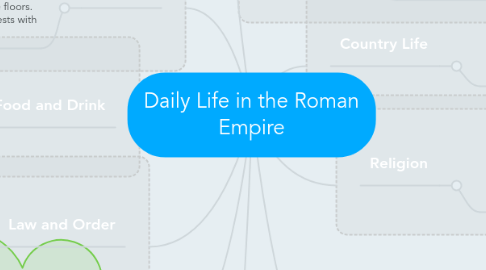Daily Life in the Roman Empire
by hayley mineer

1. Daily life of Ancient Rome
1.1. In Ancient Rome nearly one million people lived in the empire’s capital city. Rome was full of beautiful temples, stately palaces, and flowering gardens.Wealthy Romans spent great sums of money on silks, perfumes, jeweled weapons, and musical instruments. They decorated their homes with statues, fountains, and fine pottery.
2. Law and Order
2.1. The Romans always followed laws and rules. As one Roman judge said, “Whatever pleases the emperor is the law.” Romans believed that one law should apply to all citizens. Still, under the empire, Roman law was not applied equally. The poor, who were often not citizens, faced harsher punishments than the rich; sometimes even torture. They all had different stiles of clothes depending on what class they were in.
3. Food and Drink
3.1. Only the rich had kitchens. The poor cooked on small grills or bought “fast food.” The main foods were bread, beans, spices, vegetables, cheeses, meats, and garum. Drinks included water and hot water with herbs and honey. For dinner, poor Romans might have chunks of fish along with some asparagus and a fig for dessert. Wealthy Romans ate more elaborate dinners. Besides the main part of the meal, they had special appetizers. Some favorites were mice cooked in honey, roasted parrots stuffed with dates, salted jellyfish, and snails dipped in milk.
4. Housing
4.1. TheLike food, housing was very different in Rome for the rich and for the poor. The spacious, airy homes of the rich stood side by side with the small, dark apartments that housed the poor. Wealthy Romans lived in grand houses, built of stone and marble. Thick walls shut out the noise and dirt of the city. Inside the front door was a hall called an atrium where the family received guests. An indoor pool helped to keep the atrium cool. An opening in the roof let in plenty of light. Beyond the atrium, there were many rooms for the family and guests. The fanciest room was the dining room. Its walls were covered in pictures, both painted murals and mosaics made of tiles. Mosaics also decorated the floors. Graceful statues stood in the corners. Some dining rooms had beautiful fountains in the center to provide guests with cool water.
5. Recreation
5.1. Men and women sat in separate sections at the Colosseum, but could sit together at the Circus Maximus. A Roman poet said the Circus Maximus was the best place to meet a new boyfriend or girlfriend because you never knew who would sit next to you. Both rich and poor often relaxed at Rome’s public baths. There they could bathe, swim, exercise, and enjoy a steam bath or a massage. The baths also had gardens, libraries, shops, and art galleries. Roman emperors made sure to give the poor “bread and circuses”—food and entertainment—to keep them busy and happy. Besides the many festivals throughout the year, rich and poor alike flocked to two spectacles: gladiator contests and chariot races.
6. Religion
6.1. The religion in Rome was the Romans adopted many Greek gods. They also adopted gods from other cultures to create their own group of gods.Festivals and holidays, or “holy days,” were held throughout the year to honor the gods. Someone who were injured or sick they would Romans would leave a small offering at a temple in the shape of the hurt part of the body. Romans pleased their gods in many ways.
7. Family Life
7.1. The family life in Rome was ruled by “father of the family.” A Roman father’s word was law in his own home. Even his grown sons and daughters had to obey him. Between the ages of 14 and 18, a Roman boy celebrated becoming a man. In a special ceremony, he offered his bulla, along with his childhood toys and clothes, to the gods. Roman girls did not have a ceremony to mark the end of childhood. They became adults when they were married, usually between the ages of 12 and 18. Weddings were held at a temple. The bride wore a white toga with a long veil. The groom also wore a white toga, along with leather shoes that he had shined with animal fat. But the new husband did not become a paterfamilias until his own father died.
8. Education
8.1. If you had grown up in ancient Rome, your education would have depended on the type of family you were born into. Many poor children in Rome were sent to work instead of to school. They learned trades, such as leatherworking and metalworking, to help earn money for their families. In wealthier families, boys and girls were tutored by their fathers, or often by slaves, until they were about six years old. Then boys went off to school. Classes were held in public buildings and private homes. Many of the tutors were educated Greek slaves. A typical school day in Rome began very early in the morning. Students walked through crowded streets, carrying their supplies in a leather shoulder bag. On the way, they stopped at local breakfast bars. There they bought beans, nuts, and freshly baked bread to munch on while they walked to class.
9. Country Life
9.1. Ninety percent of the empire’s people lived in the country. The wealthy often owned villas. Farms provided much of the food for the cities. Slaves did much of the farm work. Many country people were not slaves, but their lives were hard. They lived in huts and worked their own small farms or on the great estates.


